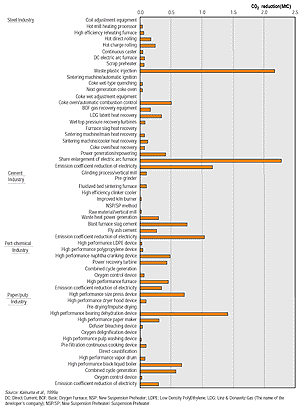|
9.2.6 Manufacturing
The effects of GHG mitigation on manufacturing sectors are likely to be very
mixed, depending on the use of carbon-based fuels as inputs, and the ability
of the producer to adapt production techniques and to pass on increases in costs
to customers. Different manufacturing processes and technologies use carbon-based
inputs in very different amounts in relation to output. High carbon-intensive
sectors (using the UN System of National Accounts 1993 ISIC, p. 594-5) include
basic metals (aluminium, steel), other non-metallic mineral products (cement,
bricks, glass) and some chemicals (bulk chemicals). Low carbon-intensive sectors
include office machinery (electronics) and other chemicals (pharmaceuticals).
Several large sectors (food, textiles, machinery, and vehicles) are somewhere
between these extremes.
If the Kyoto Protocol is ratified, manufacturing sectors in Annex I countries
can expect to face mitigation policies to meet national targets. The possible
options for the firms are basically: (1) energy conservation (adoption of more
efficient technologies), (2) shift to products with lower carbon intensities,
(3) accept extra taxation or emission permits and the possible effect on profits
and/or product sales and (4) shift production abroad as foreign direct investment
or joint ventures.
Generally, adopting these options will create ancillary benefits and costs.
Speculative ancillary benefits include:
- the adoption of energy conservation technologies that mitigates local air
pollution similar to the case of transportation sector;
- the accumulation of scientific and technological knowledge that contributes
to the development of new products and processes; and
- the internationalization of manufacturing that stimulates technology transfer
to developing regions and greater equity in wealth distribution.
If production is transferred to non-Annex B countries, ancillary costs include
- losses in Annex B manufacturing employment; and
- increases in non-Annex B emissions.
Thus, the assessment of the effects of climate policy on manufacturing could
take into account the interactions between sectors and economies. Multisectoral
and multi-regional models have been used to evaluate them (see 9.2.6.1
below).
9.2.6.1 Effects on Manufacturing from Multisectoral Top-down
Studies
Manufacturing sectors show mixed results in the multisectoral studies (see
Table 9.1 above). Reflecting industrial and financial
globalization, recent studies tend to involve international trade on both goods
and capital. In the main example, McKibbin et al. (1999) evaluate
the potential sectoral impacts of the Kyoto Protocol using the G-Cubed model,
mainly focusing on the real and the financial trading structure. In case of
unilateral action by the USA, the effects on manufacturing industries show at
most 1.4% and 1.2% decrease in quantity and price, respectively, although the
effects on the energy industry sectors are large, e.g., 56% down in the coal
mining industry with a 375.6% price increase in 2020.
9.2.6.2 Mitigation and Manufacturing Employment
Some mitigation policies would increase output and employment in the energy
equipment industries. In 2010 under an innovation scenario for GHG mitigation
of 10% relative to 1990, GDP for the US is projected to increase by 0.02% (Laitner
et al. 1998). Wage and salary earnings are shown to rise in 2010
by 0.3% and employment (jobs) by 0.4%. From another perspective, these net job
gains might be all provided by new small manufacturing plants in the USA; in
that case, the redirected investments in energy-efficient and low-carbon technologies
would produce additional employment equivalent to the jobs supported by about
6200 small manufacturing plants that open in the year 2010. While these impacts
are small in relation to the larger economy, it is because the scale of investment
is also relatively small. The anticipated extra energy-efficiency and renewable-energy
investments in the year 2010 is less than 3% of US total investment in that
year.
9.2.6.3 Mitigation Measures and Technology Strategy

Figure 9.4: Contribution to carbon dioxide emission reduction by technology
options in Japan in 2010.
|
Some bottom-up studies assess the relationships between
climate policy and technological strategy. For instance, the implementation
of a carbon tax or subsidies will strongly affect the investment decisions in
manufacturing sectors. Kainuma et al. (1999a) assess how a subsidy
affects the adoption of energy conservation technologies to meet Kyoto targets
using the AIM/ENDUSE model of Japan. Figure 9.4 shows the
contribution of technologies undertaken by firms to reduce carbon emissions
in 2010. Subsidies of US$30/tC compare with a carbon tax of US$300/tC to meet
Kyoto targets without subsidies (using a rate of 100yen/$) (Kainuma et
al., 1997, 1999a).
For developing countries, environmental policy is often linked to technological
improvement. Jiang et al. (1998) assess the potential for CO2
emission reductions in China based on advanced energy-saving technology options
under various tax and subsidy measures. For example, they consider the adoption
of advanced coking-oven systems by the iron and steel industry in China. Without
changes in policy only 15.9% of existing ovens will be replaced by advanced
ones by 2010. With a carbon tax, but without a subsidy, the replacement share
rises to 62%. With a tax and subsidies for energy-saving technologies, the share
rises to 100%, i.e. the advanced ovens will be fully adopted by the industry.
They also mention that taxes with subsidies do not give the best solutions for
other sectors. They conclude that a carbon tax with subsidy could have reduced
CO2 emissions by 110Mt of carbon-equivalent in 2000 and 360Mt in
2010, from the baseline case of 980Mt in 2000 and 1380Mt in 2010.
Energy-saving technologies across the sectors, such as material and thermal
recycling have a large potential to reduce carbon emission. Yoshioka et
al. (1993) employed input-output analysis to evaluate the potential
contribution of blast-furnace cement to reduce CO2 emissions: improved
technology for the utilization of 1 tonne of blast furnace slag to produce cement
could reduce CO2 by 0.85 tonnes. In the same manner, Ikeda et
al. (1995) estimated that the utilization of by-products in the steel
and iron industry, and of steel scrap could reduce CO2 emissions
by 2.4% in Japan in 1990.
|